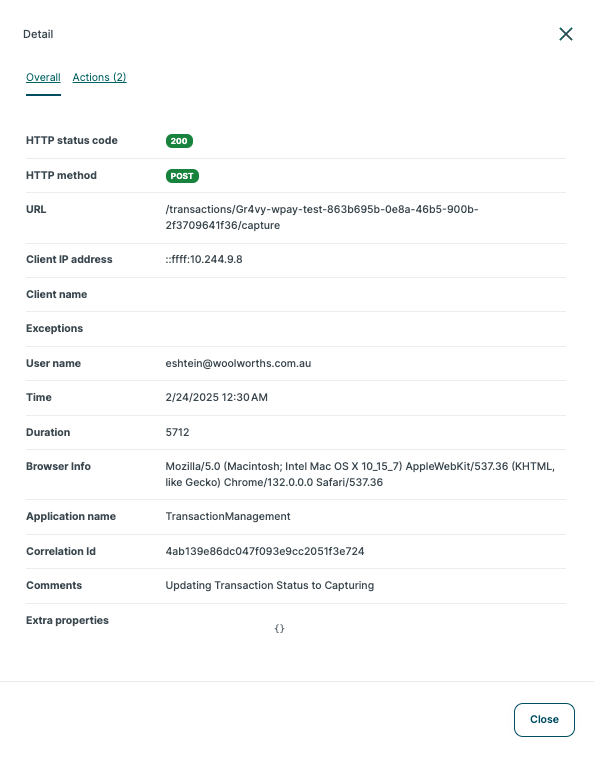Audit logging
Find out how to read your audit logs including payment actions, user log ins, user updates and reports.
Overview
An audit log object is typically created & saved per web request. It includes:
- Request & response details (like URL, Http method, Browser info, HTTP status code etc.).
- Performed actions (controller actions and application service method calls with their parameters).
- Entity changes occurred in the web request.
- Exception information (if there was an error while executing the request).
- Request duration (to measure the performance of the application).
# How to obtain audit logs for payment actions
In order to obtain audit logs for payment actions such as capture, refund and void, perform the following search.

How to search for transaction actions
In the search bar, under Application name type in "TransactionManagement" and update the URL field with the type of action you'd like to search. The options are:
- Refund
- Void
- Capture
You can also search via username. Ensure to use the user's email when searching to see all actions that user has performed.
Partial refunds and captures
For partial refunds and captures, the URL will contain refund or capture. You cannot search explicitly for partial refunds or captures.
Specific payment search
To see specific payments, take the URL of payment from the Payments overview page and paste into the search field. An example is below:

An example of a specific payment transaction search to obtain the audit log
# How to obtain audit logs for user log ins
In order to obtain audit logs for user log ins, the application name is AuthServer and the URL is /connect/token. For successful log ins, the HTTP status code will be 200 and the HTTP method will be POST. For unsuccessful logins, the HTTP status code will be 500 and the HTTP method will be POST.
# How to obtain audit logs for user updates
Creation and deletion of users
In order to obtain audit logs for updates, the application name is Wpay.Connect.IdentityService.HttpApi.Host and the URL is /api/identity/. These audit logs creation/update/deletion of users.
For successful creation of users, the HTTP status code will be 200 and the HTTP method will be POST. For unsuccessful creation of users, the HTTP status code will be 403 and the HTTP method will be POST.
For deletion of a user, the HTTP status code will be 204 and the HTTP method will be DELETE.
Organisation unit updates
For updates to a users organisation unit, the application name is Wpay.Connect.IdentityService.HttpApi.Host and the URL is /api/identity/organization-units/. For successful updates, the HTTP status code will be 204 and the HTTP method will be PUT. For unsuccessful updates, the HTTP status code will be 403 and the HTTP method will be POST.
Further details in Audit log
To obtain further details under the Audit log, select the detail button and further information will appear:

An example of further details in the Audit logs
Definitions of the items in the Audit log
| Object | Description |
|---|---|
| HTTP status code | HTTP response status code for this request. |
| HTTP method | HTTP method of the current request (GET, POST, PUT, DELETE etc.). |
| URL | URL of the request. |
| Client IP address | IP address of the client/user device. |
| Client Name | Name of the current client, if available. |
| Exceptions | An audit log object may contain zero or more exception. In this way, you can get a report of the failed requests. |
| User name | User name of the current user, if the user has logged in. |
| Time | The time when this audit log object has been created. |
| Duration | Total execution duration of the request, in milliseconds. This can be used to observe the performance of the application. |
| Browser Info | Browser name/version info of the current user, if available. |
| Application name | When you save audit logs of different applications to the same database, this property is used to distinguish the logs of the applications. |
| Correlation Id | Correlation Id is used to relate the audit logs written by different applications (or microservices) in a single logical operation. |
| Comments | An arbitrary string value to add custom messages to the audit log entry. An audit log object may contain zero or more comments. |
Updated 9 months ago
